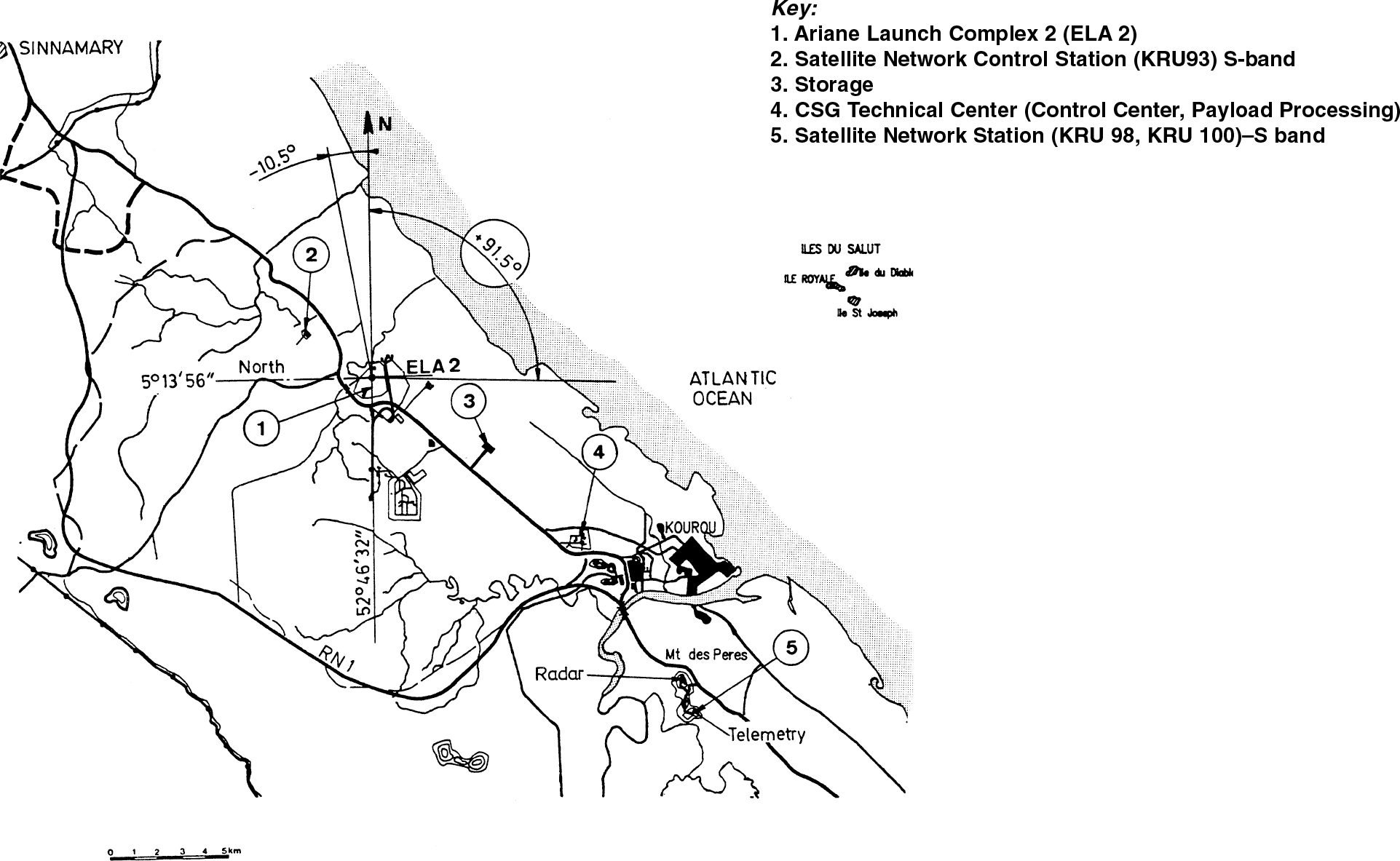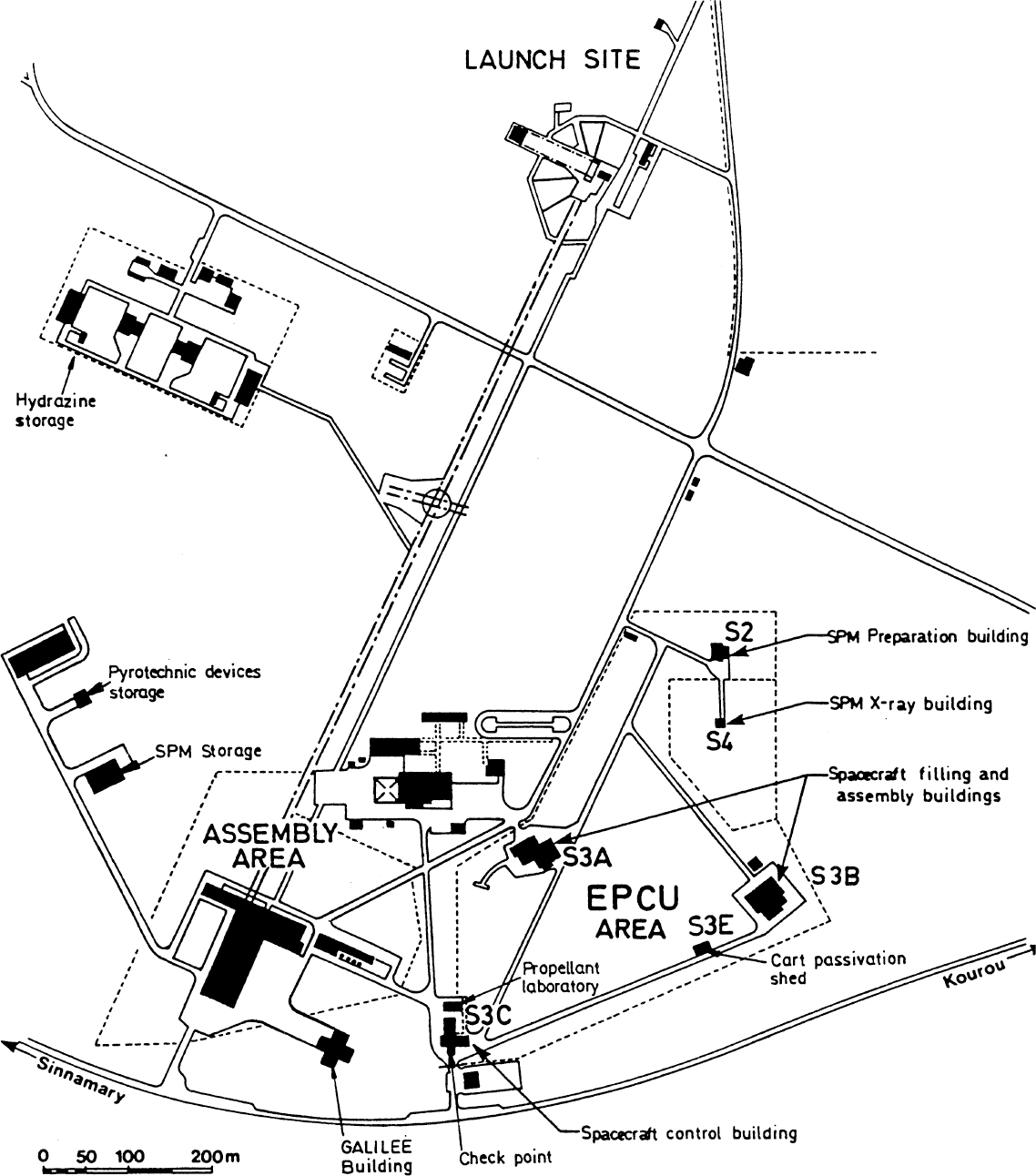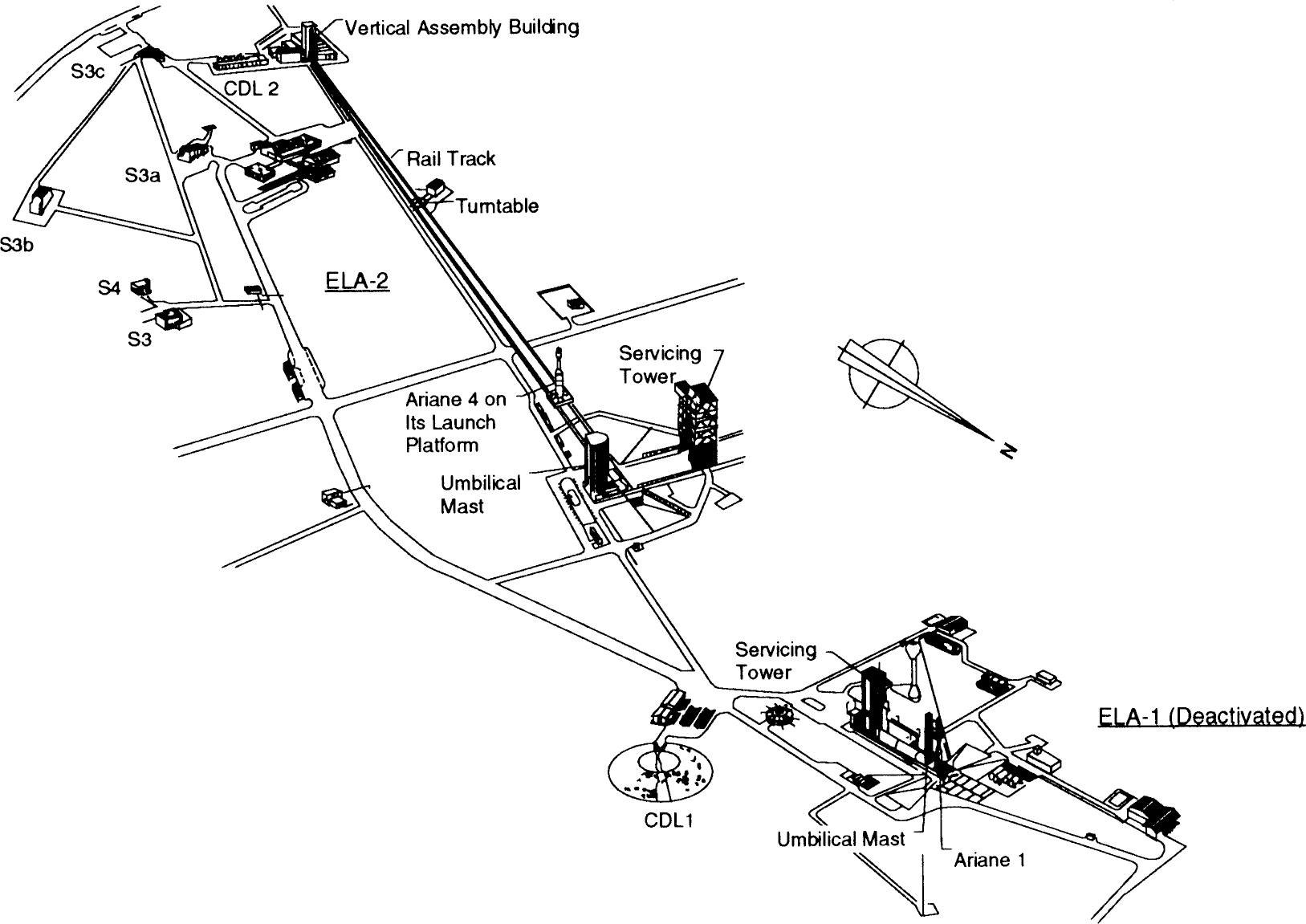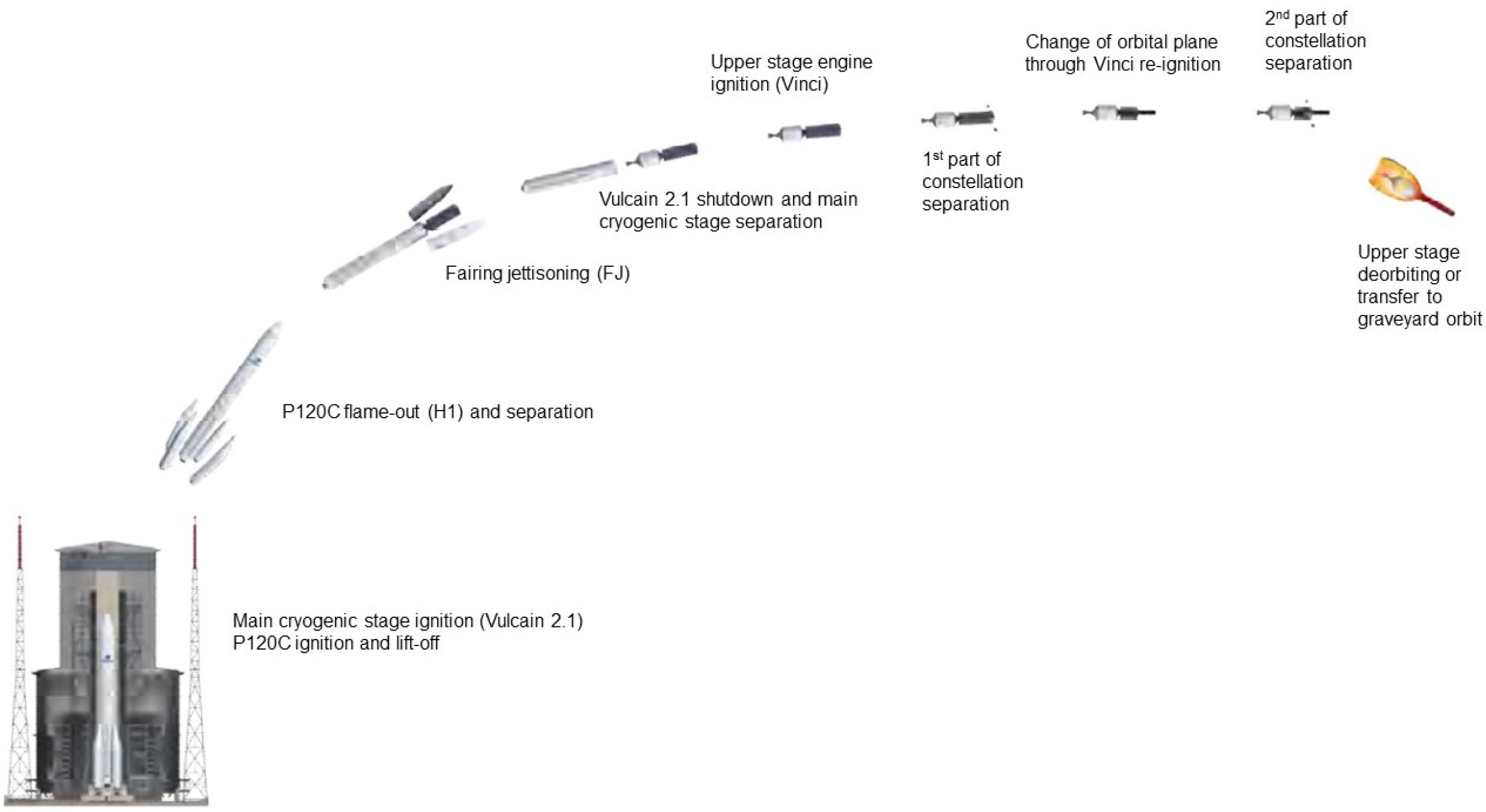Ariane
Production and Launch Operations
Production
ESA rules dictate that work on the Ariane program be divided up among member nations in proportion to the amount each country contributed to the vehicle development program. As a result, Ariane vehicles are produced for Arianespace by roughly 50 European companies, with responsibility for stages and primary elements spread among the members’ major aerospace firms. The countries with the largest work shares are France (50.6% of Ariane 4 and 42.1% of Ariane 5), Germany (22.7% and 21.5% respectively), and Italy (6.0% and 14.1%). Much of the final assembly is performed at EADS’s Les Mureaux facility outside of Paris (formerly an Aerospatiale factory), and at Astrium in Bremen (formerly a DASA facility). The assembled stages are shipped from Europe to French Guiana in the cargo vessel MN Toucan. The only significant production done in French Guiana is the propellant casting of the two large segments of the Ariane 5 solid booster, which are too large to ship from Europe. The smaller forward segment with the igniter is manufactured and cast in Italy at FiatAvio’s Colleferro facility.
The following companies have significant production responsibilities for Ariane vehicles.
Contractors | Ariane 5 | Contractors | Ariane 6 |
EADS Launch Vehicles | industrial architect EPC core stage, EAP boosters, | EADS Launch Vehicles | industrial architect core stage, boosters, |
Astrium | EPS and ESC upper stages, Speltra, Sylda 5, Aestus engine for EPS, Vulcain thrust chamber, payload adapters | Astrium | upper stage, Vulcain thrust chamber, |
CASA | payload adapters | CASA | payload adapters |
Europropulsion | solid motor propulsion | Europropulsion | solid motor propulsion |
FiatAvio | solid rocket motors, Vulcain LOX turbopump | FiatAvio | solid rocket motors, Vulcain LOX turbopump |
MAN Technologie | solid booster cases, EPS tanks | MAN Technologie | solid booster cases, EPS tanks |
Contraves Space | payload fairing | Contraves Space | payload fairing |
Regulus | solid booster propellant | Regulus | solid booster propellant |
SAAB Ericsson | payload adapters | SAAB Ericsson | payload adapters |
SFENA | ring laser gyros | SFENA | ring laser gyros |
Snecma | Vulcain 1 and 2 engines, HM7B for ESC-A | Snecma | Vulcain 2.1 engine |
|
| Avio | Vinci engine |
Volvo Aero | Vulcain 2 nozzle | Volvo Aero | Vulcain 2.1 nozzle |
Launch Operations

Launch Facilities

Ariane Launch Complex (ELA-2)

ELA-1 and ELA-2 Facilities Layout

ELA-3 Facilities Layout
Launch Operations—Guiana Space Center
Ariane launches are conducted from the ELA (Ensemble de Lancement Ariane) launch sites at the Guiana Space Center (Centre Spatial Guyanais, CSG) near Kourou, French Guiana, in South America. The space center includes all facilities used for a launch campaign sequence, including Ariane launch complexes, payload preparation complex, and downrange stations.
The CSG facilities are spread over a 18-km (11-mi) strip of the Atlantic coast, between Kourou and Sinnamary. The CSG is located close to the equator (latitude 5.23° N), which makes it well located for launching satellites into GEO. In addition, a broad launch sector over the Atlantic Ocean extends from north to east (–10.5 to +91.5 deg launch azimuth), making CSG one of the few launch sites in the world that can efficiently launch both GTO and polar satellites. The CSG is responsible not only for supplying the overall logistic support during launch activities but also operating the tracking and telemetry networks (including the processing of all launch vehicle telemetry data) and for the safety of personnel and the protection of the facilities. Owned by ESA, the launch sites are operated by Arianespace, which also maintains the launch facilities. The fixed costs of operating CSG are paid by European governments. The budget allotment for the five year period 2002–2006 was 617 million, ($606 million), or about $120 million per year.
ELA-1 was originally used for launching Europa 2, and later for launching Ariane 1, 2, and 3 before being deactivated. ELA-2 was used for Ariane 3 and currently is used for Ariane 4. ELA-3 was constructed for Ariane 5. For the eastward launches, the CSG radar, telemetry, and telecommand stations are supported by three downrange stations to continuously receive data on the launch vehicle's trajectory and behavior in flight. These are located at Natal, Brazil, on Ascension Island in the South Atlantic, and near Libreville, Gabon.
Payload processing occurs at the payload preparation complex (EPCU), which is owned by ESA and operated by CSG for Arianespace customers. The EPCU is designed for the preparation of satellites in a single- or dual-launch configuration, and includes all facilities placed at the disposal of Arianespace customers for the preparation of their satellites, from their arrival in French Guiana up to the actual mounting of the payload on the Ariane launch vehicle. The EPCU consists of a number of geographically dispersed buildings. Buildings S1A and S1B are located in the CSG technical center, and provide clean-room facilities for satellite receiving, final integration, and testing of electrical, mechanical, optical, and pneumatic systems. Solid kick motor preparation is performed in buildings S2 and S4, near the ELAs. These facilities are designed for x-ray inspection, and installation of pyrotechnic devices on the motors. Satellite fueling operations are conducted in building S3A and S3B near the two ELAs. Building S3C is located near S3A and S3B, and is used for monitoring and control of hazardous operations. For Ariane 4, final integration, assembly of the satellites on a Sylda or Spelda dual launch system, and satellite encapsulation into the payload fairing are performed in buildings S3A and S3B. For Ariane 5, these operations are performed in the Final Assembly Building (BAF) at ELA-3. In 2001 Arianespace opened the new S5 facility, built at a cost of 75 million francs ($11.3 million). The S5 facility has two preparation halls designed to handle the new generation of large satellites, including not only large GEO satellites but also even larger LEO spacecraft such as Envisat and the ATV, which will weigh up to 20 t (44,000 lbm). All satellite processing tasks, including the loading of up to 10 t (22,000 lbm) of propellant, can be accomplished in the S5 building avoiding the need to move the spacecraft to multiple facilities for different functions.
Ariane 4
Ariane 4 is prepared and launched at ELA-2. This facility allows the minimum interval between two launches to be reduced to less than three weeks, compared to two months on ELA-1, thus providing considerably greater flexibility in launch scheduling. While the concept of the ELA-1 complex called for the vehicle erection and assembly directly on the pad, the ELA-2 vehicle assembly and checkout takes place in a remote VAB. The vehicle is then moved on its launch table to the launchpad. While this vehicle is undergoing final preparation on the pad, the next one can already be erected in the VAB on a second mobile launch table.
A typical Ariane 4 launch campaign starts about nine weeks before the launch, with the transport of all the vehicle hardware in special containers, first on the Seine from Les Mureaux to Le Havre and then by ship to Cayenne, French Guiana. Propellants (except LOX, which is produced in Kourou) are also loaded onboard at Le Havre. Some 10 days later the vessel arrives at the port of Cayenne, from where the launch vehicle and propellants are transferred by truck to the launch site, some 15 km (9 mi) west of Kourou. In the VAB, the launch vehicle is erected on the mobile launch table and liquid strap-ons, if required, are attached. Mating and checkout in the VAB take three to four weeks. The vehicle, on one of its two mobile tables, is pulled by truck for about 50 min along a rail track 1 km (0.6 mi) long to the pad. At the pad, solid strap-ons, if required, are attached.
In parallel, the payload, which has been flown to Cayenne, is prepared at the EPCU. At building S3A/B, payloads are encapsulated in the payload fairing, making a transport container superfluous and reducing the time needed for payload preparation in the launch tower. The fully integrated upper component consisting of the VEB structure, the Spelda, if needed, the payload(s), and the fairing is transported to the launch pad and installed on top of the vehicle five working days before launch.
The launch countdown, covering mainly the filling of the stages with propellants, takes about 38 h distributed over three days. At about 10 and 5 h before launch, balloons are released for winds-aloft measurement. The keepout zone for lightning, which occurs mostly during July and August, is 8 km (5 mi). During the last 6 min before launch initiation, the ground checkout system verifies the proper functioning of the vehicle. It also separates the propellant transfer arms from the third stage 5 s before the end of the sequence, and finally commands ignition of the four first-stage engines and of the liquid-propellant boosters.
After ignition, the ground checkout system monitors the functional parameters of the ignited engines. If their status is correct, the command to open the jaws holding the launcher is given at the same time as that to ignite the solid propellant boosters. The typical flight time for the Ariane 4 launch vehicle, up to third-stage engine shutdown, is 17–18 min. The ELA-2 launch complex is capable of supporting 10–12 launches per year.
Ariane 5
Ariane 5 is launched from the ELA-3 complex near ELA-2. The ELA-3 launch site was required to maintain a high launch rate of 10 Ariane 5 vehicles per year, while reducing costs for investment, operations, and maintenance. To fulfill these requirements, ELA-3 was designed for a launch process different from that used at ELA-2. Preparation and checkout of the launch vehicle components are done in parallel, in separate buildings designed for each task, thus reducing the total time needed for the launch campaign. The payload is checked and encapsulated in the fairing before being installed on the launch vehicle. Final vehicle assembly, checkout, and payload integration are done in a fixed building, after which the launch vehicle is transported to a simple pad on a mobile launch table. Only cryogenic propellant loading and the launch take place at the pad, eliminating the need for complex mobile service structures, and reducing the amount of infrastructure that must be replaced in the event of an accident. The parallel operations allow the typical launch campaign to take only three weeks.
ELA-3 is divided into two zones, the preparation zone and the launch zone. The preparation zone consists of four main buildings: Booster Integration Building (BIP), Launcher Integration Building (BIL), Final Assembly Building (BAF), and Preparation and Launch Control Center (CDL 3). These buildings are widely separated because of safety constraints imposed by the use of solid-propellant boosters.
The BIP is where the solid boosters are assembled and checked out. The center and aft booster segments are assembled and cast onsite in a plant located near the BIP, because it would be difficult to safely transport such large motors from Europe. The smaller forward segment is produced in Italy. In the BIP, the segments are mated in two integration rooms on two special devices that are used to transfer the booster. The boosters are fully prepared and checked before leaving.
In the BIL, the EPC cryogenic stage, shipped from Europe, is erected and mated on the launch table. The VEB and EPS stage are integrated onto the core stage. Both solid boosters are then mounted on the launch table. Electrical, mechanical, and fluid systems are checked, and the vehicle is prepared for mating with the payload.
In the BAF, the payload component is assembled and erected, the fairing is assembled, the EPS tanks are filled, and the final electrical checkout is done. The upper payload is attached to the upper Speltra interface and encapsulated in the fairing in the ground-level encapsulation hall, which has a 30 t (66 klbm) crane. The lower payload is integrated directly on the Ariane 5, and then the encapsulated assembly containing the upper payload is lifted over the Ariane 5 and mated to it, enclosing the lower payload. In effect, the BAF replaces the mobile gantry used at ELA-2. After integration and testing, the launch vehicle is transferred on the launch table along a twin railway track from the preparation zone to the launch zone in a fully integrated state. Roll out to the pad can occur less than a day before launch.
The launchpad is in the launch zone. This area includes deflectors and exhaust ducts, a small building protecting the electrical and fluid connections, and a water tower to supply noise suppressing water. A few days before launch, the pad’s cryogenic storage tanks are filled with propellants trucked from the cryogenic propellant plant. Four tall towers serve as lightning rods. This simple design permits a sustained launch rate and, in case of a pad accident, minimal stand-down. The launch facility was modified to support the ESC-A cryogenic upper stage, by adding a pair of articulated retractable arms that load LOX and LH2 into the upper stage from the umbilical tower.
At the CDL3, operations are controlled and monitored down to the moment of launch. Checkout and command equipment allows the activation of two launchers at the same time, so that a second booster can be assembled while the first is on the pad.
Flight Sequence

Typical Ariane 6 ascent profile
Once the engine of the cryogenic main core stage (LLPM), Vulcain 2.1, is ignited, the on-board computer checks the good behavior of the engine and authorizes the lift-off by the ignition of the two or four solid rocket boosters, depending on the configuration of the launcher. The boosters’ separation is triggered by an acceleration threshold detection and the fairing is released approximately one minute later when the aerothermal flux becomes lower than the required flux (1,135 W/m2 is the standard value). Then the LLPM pursues its flight alone until reaching the ULPM injection orbit. The separation happens 6 seconds after.
The reignitable upper stage (ULPM) phase typically consists of one, two or more burns to reach the targeted orbit, depending on the orbit altitude, eccentricity and inclination.
- For elliptic equatorial orbit including GTO, super GTO or subGTO, a single boost injects the upper composite into the targeted orbit (direct ascent profile);
- For circular orbit, highly inclined orbit or GTO+, a first burn is used to reach an intermediate orbit, followed by a coast phase which duration depends on the targeted orbit, and a second burn to reach the final orbit;
- In case of launch with multiple payloads, several burns can be performed to transfer the payloads to a wide variety of final orbits, providing the required plane changes and orbit raising.
After the S/C separation(s), upper stage will perform orbit disposal manoeuver like a controlled re-entry in the Earth atmosphere. The flight profile is optimized for each mission. In the case of specific mission profiles, please contact Arianespace.
Ariane 6 is also able to perform multiple separations with a payload dispenser, or for auxiliary payloads with standardized carrying structures.

Typical Ariane 6 launch sequence for a satellite constellation deployment